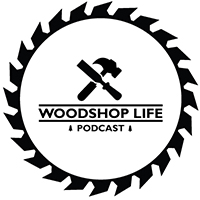Support us on Patreon: https://www.patreon.com/woodshoplife
Guys Questions:
1) First thanks for the great podcast y’all have put together I really enjoy listening. I am looking for a new bandsaw for the shop. I had a 18” Jet bandsaw that I really liked but it was just to big for my shop. I am looking for a 14” bandsaw to replace the old one. I have looked at the Jet JWBS14-SFX and the Laguna 14/12 and the Laguna 14BX 2.5 HP models. There is not a huge price difference in them but I have also noticed that Harvey Woodworking has a bandsaw that looks very similar to the Laguna 14BX but I have not seen or heard of them before. I believe the Jet has ball bearing guides and the Laguna has ceramic. Do any of you have an opinion on these saws. My local Woodcraft has both Laguna machines and the Jet in store but I am torn between them. Any help would be much appreciated. Keep up the good work guys! – Troy
2) Hey all, love the show – Guy is looking handsome as ever –
I’ve been watching a lot of old New Yankee workshop and noticed that Norm reinforces like EVERYTHING with brad nails – I’m especially talking about show faces on projects like the shaker wall clock he built – he shot like 10 brads into face grain on the sides of the clock where everyone will see –
I’m sure he is hiding them in the finishing process with a filler, but I’m wondering if a brad is really necessary on non load bearing joints / projects – We have all seen the tightbond ads showing that the glue joint is actually stronger than the wood itself – Do I really need to brad / pin nail in a divider piece on a wall clock? Or trim molding that is glued otherwise??
SB
Seans Questions:
1) How do you decide what the next Purchase in the shop will be with a given budget? I have 1500-2k I can spend so I’m debating between many different things
2) Hey guys I have just got into listening to the podcast and have really enjoyed it. I was wondering how do y’all go about selling the projects that you make and where to advertise the pieces so that they get sold. Also what are some good ways to get your name out to the community to let them know about you and the skills that you have.
Thanks, Logan
Huys Questions:
1) My question concerns instagram/maker etiquette. I am a novice in woodworking/cabinetry, and I am always curious what other maker costs are in some of their projects. I guess my question is, is it ok to ask other makers how much they have in a project and what their net profits are on the project?? I’d like to know how I’m doing when it comes to margins. -Cole
2) The WWGOA has made a pretty big push lately regarding the Harvey “Ambassador” Cabinet Table Saw. Would you share your thoughts on the C200 & C300 models? I have been saw shopping for some time, reviewing all available “cabinet style” brands, and recently put this saw into the mix of choices.
